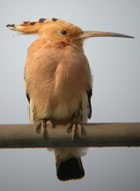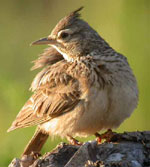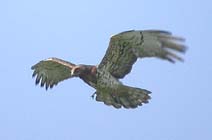 |
Extremadura - principal habitats
Pseudosteppe
Pseudosteppe is steppe habitat (treeless open grasslands here forming a mosaic with
agricultural fields) which developed after the natural tree and scrub cover which once
dominated had been cleared by man, and is maintained through grazing and / or agricultural
practices (it would return to scrub and trees if left untouched). The rather low rainfall
combined with long summer drought and fierce summer temperatures (<40°C) characterise these
areas where the main growing period is through the winter, starting after the first autumn
 Hoopoe Upupa epops
© John Muddeman
rains (usually October).
Hoopoe Upupa epops
© John Muddeman
rains (usually October).
Dehesa
One of the dominant habitats of the whole area is formed by huge extensions of dehesa. These are typically
rather open tracts of holm oak (Quercus rotundifolia ssp. ballota) woodland (rarely cork oak Q. suber or
even narrow-leaved ash Fraxinus angustifolia), with an appearance rather like open parkland, and sometimes
 Crested Lark Galerida cristata
© John Muddeman
referred to as the "Spanish savannah" given its visual similarity. All the main trees are periodically
pruned to remove 'excess' wood for making charcoal or for burning and the regrowth stimulates the
production of acorns, on which the famous Iberian or 'pata negra' pigs forage to acquire their special taste.
While the majority of these areas have grazed pasture underneath, it is actually a mosaic of different
structures and habitats, with management often carried out in loose rotation. Plots are occasionally
ploughed and poor crops of wheat or barley harvested from underneath. This is then left fallow and
grazed by sheep and foraged by pigs, finally returning to a short-sward of grass and wild flowers
grazed by sheep, and locally, fighting bulls. If left with no management, swathes of flowers appear,
followed quickly by scrub, the holm oak saplings take root and eventually the area ends up as thick scrub.
Crested Lark Galerida cristata
© John Muddeman
referred to as the "Spanish savannah" given its visual similarity. All the main trees are periodically
pruned to remove 'excess' wood for making charcoal or for burning and the regrowth stimulates the
production of acorns, on which the famous Iberian or 'pata negra' pigs forage to acquire their special taste.
While the majority of these areas have grazed pasture underneath, it is actually a mosaic of different
structures and habitats, with management often carried out in loose rotation. Plots are occasionally
ploughed and poor crops of wheat or barley harvested from underneath. This is then left fallow and
grazed by sheep and foraged by pigs, finally returning to a short-sward of grass and wild flowers
grazed by sheep, and locally, fighting bulls. If left with no management, swathes of flowers appear,
followed quickly by scrub, the holm oak saplings take root and eventually the area ends up as thick scrub.
The dehesa is also a vitally important habitat for wildlife, having formed over centuries and managed in a
sustainable way. Large tracts are inaccessible, especially where used for rearing bulls, and given the very low
levels of disturbance and high livestock numbers are of vital importance for large populations of breeding and
hunting raptors in particular.
Other Habitats
 Short-toed Eagle Circaetus gallicus
© John Muddeman
Short-toed Eagle Circaetus gallicus
© John Muddeman
There are numerous other habitats too, e.g. from vast reservoirs and ever increasing numbers of rice fields
along the main rivers to natural riverine scrub and valley side woodland along the remaining stretches of un-dammed
rivers (sadly, very few of the latter now). The sunny and shady flanks of the steep hill and valley-sides support
rather different plant communities, while the large altitudinal variation, especially in the N mountains supports
a suite of habitats characteristic of the different heights, culminating in exposed rocky tops studded with
ground-hugging plants.
|